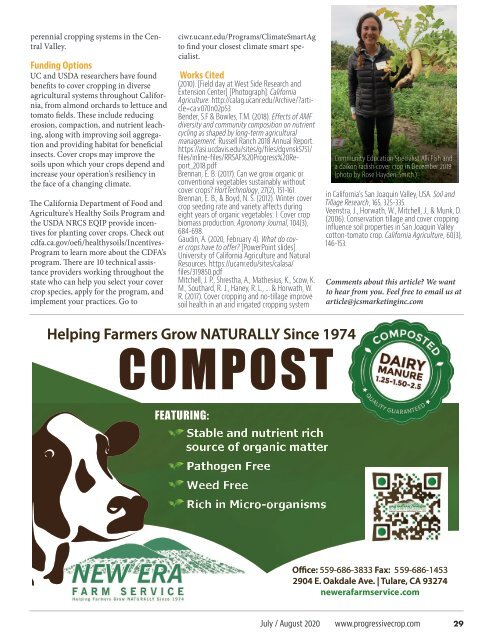You also want an ePaper? Increase the reach of your titles
YUMPU automatically turns print PDFs into web optimized ePapers that Google loves.
perennial cropping systems in the Central<br />
Valley.<br />
Funding Options<br />
UC and USDA researchers have found<br />
benefits to cover cropping in diverse<br />
agricultural systems throughout California,<br />
from almond orchards to lettuce and<br />
tomato fields. These include reducing<br />
erosion, compaction, and nutrient leaching,<br />
along with improving soil aggregation<br />
and providing habitat for beneficial<br />
insects. Cover crops may improve the<br />
soils upon which your crops depend and<br />
increase your operation’s resiliency in<br />
the face of a changing climate.<br />
The California Department of Food and<br />
Agriculture’s Healthy Soils Program and<br />
the USDA NRCS EQIP provide incentives<br />
for planting cover crops. Check out<br />
cdfa.ca.gov/oefi/healthysoils/Incentives-<br />
Program to learn more about the CDFA’s<br />
program. There are 10 technical assistance<br />
providers working throughout the<br />
state who can help you select your cover<br />
crop species, apply for the program, and<br />
implement your practices. Go to<br />
ciwr.ucanr.edu/Programs/ClimateSmartAg<br />
to find your closest climate smart specialist.<br />
Works Cited<br />
(2010). [Field day at West Side Research and<br />
Extension Center] [Photograph]. California<br />
Agriculture. http://calag.ucanr.edu/Archive/?article=ca.v070n02p53<br />
Bender, S.F & Bowles, T.M. (2018). Effects of AMF<br />
diversity and community composition on nutrient<br />
cycling as shaped by long-term agricultural<br />
management. Russell Ranch 2018 Annual Report.<br />
https://asi.ucdavis.edu/sites/g/files/dgvnsk5751/<br />
files/inline-files/RRSAF%20Progress%20Report_2018.pdf<br />
Brennan, E. B. (2017). Can we grow organic or<br />
conventional vegetables sustainably without<br />
cover crops? HortTechnology, 27(2), 151-161.<br />
Brennan, E. B., & Boyd, N. S. (2012). Winter cover<br />
crop seeding rate and variety affects during<br />
eight years of organic vegetables: I. Cover crop<br />
biomass production. Agronomy Journal, 104(3),<br />
684-698.<br />
Gaudin, A. (<strong>2020</strong>, February 4). What do cover<br />
crops have to offer? [PowerPoint slides].<br />
University of California Agriculture and Natural<br />
Resources. https://ucanr.edu/sites/calasa/<br />
files/319850.pdf<br />
Mitchell, J. P., Shrestha, A., Mathesius, K., Scow, K.<br />
M., Southard, R. J., Haney, R. L., ... & Horwath, W.<br />
R. (2017). Cover cropping and no-tillage improve<br />
soil health in an arid irrigated cropping system<br />
Community Education Specialist Alli Fish and<br />
a daikon radish cover crop in December 2019<br />
(photo by Rose Hayden-Smith.)<br />
in California’s San Joaquin Valley, USA. Soil and<br />
Tillage Research, 165, 325-335.<br />
Veenstra, J., Horwath, W., Mitchell, J., & Munk, D.<br />
(2006). Conservation tillage and cover cropping<br />
influence soil properties in San Joaquin Valley<br />
cotton-tomato crop. California Agriculture, 60(3),<br />
146-153.<br />
Comments about this article? We want<br />
to hear from you. Feel free to email us at<br />
article@jcsmarketinginc.com<br />
Helping Farmers Grow NATURALLY Since 1974<br />
FEATURING:<br />
Office: 559-686-3833 Fax: 559-686-1453<br />
2904 E. Oakdale Ave. | Tulare, CA 93274<br />
newerafarmservice.com<br />
<strong>July</strong> / <strong>August</strong> <strong>2020</strong> www.progressivecrop.com 29


















